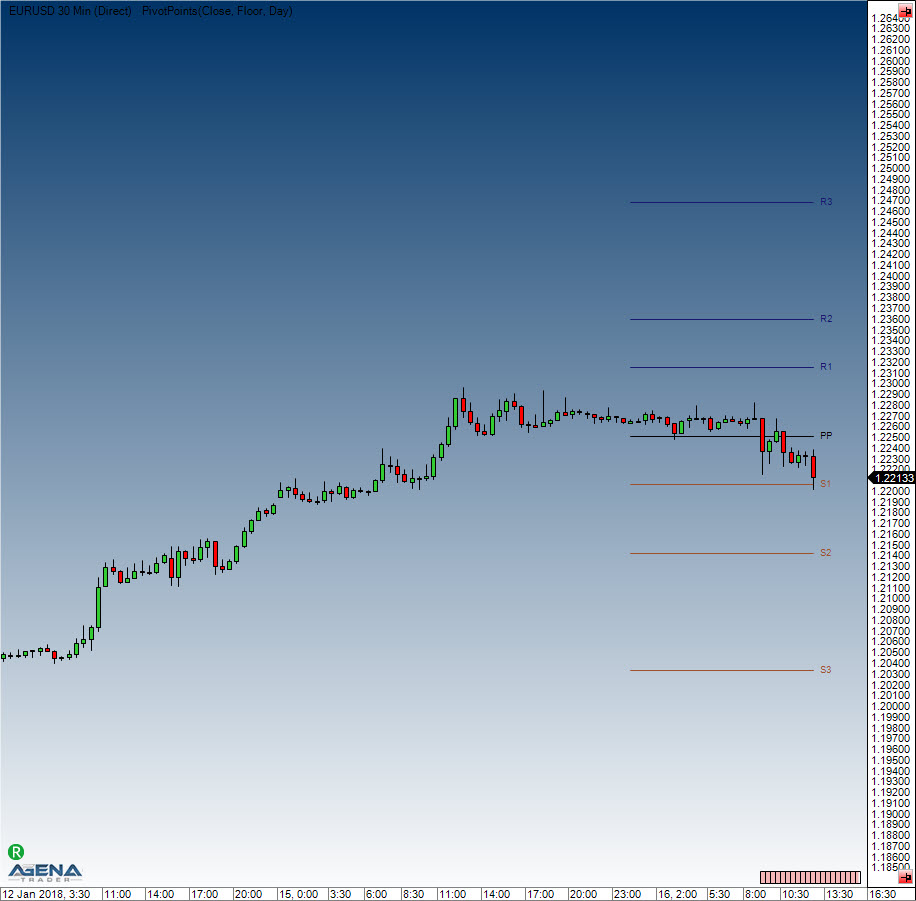Pivot Points
Description
This indicator, based on the price zone approach invented by Dr. Bruce Gould, has been honed over the years. In the beginning, the price zones were calculated using the price developments of the last 2-3 years. Nowadays, however, the practical concept of pivot points is taken from the calculation of price zones in the daily chart, using the previous day’s periods as the basis. The goal hereby is to determine price levels that one could use as potential resistance zones (R1..R3) or support zones (S1..S3). The following methods can be used to calculate the indicator: Classic, Floor, Woodie, Camarilla, Fibonacci. The Classic and Floor methods are often wrongly named within literature, which is why in AgenaTrader you will find that the Classic method is labeled as “Floor” and vice versa. The indicator displays the pivot points for intraday charts, and the parameter “ShowPrices” allows you to display the price on the levels. The parameter “DaysBack” allows you to set the number of periods in the past that should be used for the calculation. The line coloring can be defined manually
Interpretation
Traders prefer to sell above the resistance lines 1 & 2 (e.g. to build up short positions), and to start building up tactical long positions at the support lines.
Further information
http://www.aktienboard.com/forum/f38/7-kapitel-pivot-points-t36428/
http://www.forexschule.com/schule/wie-man-mit-hilfe-von-pivot-punkten-handelt-50
Usage
PivotPoints()
PivotPoints(PivotPointsMode mode)
PivotPoints(PivotPointsMode mode, int LineWidth, bool ShowPrices, int DaysBack, Color RColor, Color PPColor, Color SColor)
PivotPoints(IDataSeries inSeries, PivotPointsMode mode, int LineWidth, bool ShowPrices, int DaysBack, Color RColor, Color PPColor, Color SColor)
PivotPoints()[barsAgo]
PivotPoints(PivotPointsMode mode)[barsAgo]
PivotPoints(PivotPointsMode mode, int LineWidth, bool ShowPrices, int DaysBack, Color RColor, Color PPColor, Color SColor)[barsAgo]
PivotPoints(IDataSeries inSeries, PivotPointsMode mode, int LineWidth, bool ShowPrices, int DaysBack, Color RColor, Color PPColor, Color SColor)[barsAgo]Return value
This class has the following public methods (as data series), which all return double values:
PP, S1, S2, S3, R1, R2 ,R3
Example:
Parameters
InSeries
Input data series for the indicator
PivotPointsMode
Calculatory method. Default: floor
PivotPointsMode.Classic
PivotPointsMode.Floor
PivotPointsMode.Woodie
PivotPointsMode.Camarilla
PivotPointsMode.Fibonacci
LineWidth
Default: 1
ShowPrices
Shows prices next to the lines. Default:false
DaysBack
The number of historical periods to be included in the display of the pivot lines Default:0
RColor
Resistance line color
PPColor
Pivot line color
SColor
Support line color
Show Regions
Color fill space between lines
Extend Lines to Future
Extend lines to latest data
Visualization

Example
Calculation
H=yesterday’s high, L=yesterday’s low, O=yesterday’s open, C=yesterday’s close
Range = H-L
Classic
pp = (H + L + C)/3
r1 = 2*pp - L
s1 = 2*pp - H
r2 = pp - s1 + r1
s2 = pp - r1 + s1
r3 = H + 2*(pp - L)
s3 = L - 2*(H - pp)
Floor
pp = (H + L + C)/3
r1 = 2*pp - L
s1 = 2*pp - H
r2 = pp + Range
s2 = pp - Range
r3 = pp + 2*Range
s3 = pp - 2*Range
Woodie
pp = (H + L + 2*C)/4
r1 = 2*pp - L
s1 = 2*pp - H
r2 = pp + H - L
s2 = pp - H + L
r3 = 0.0
s3 = 0.0
Camarilla
pp = (H + L + C)/3
r1 = C + Range * 1.1 / 12
s1 = C - Range * 1.1 / 12
r2 = C + Range * 1.1 / 6
s2 = C - Range * 1.1 / 6
r3 = C + Range * 1.1 / 4
s3 = C - Range * 1.1 / 4
Fibonacci
pp = (H + L + C)/3
r1 = pp + 0.382 * Range
s1 = pp - 0.382 * Range
r2 = pp + 0.618 * Range
s2 = pp - 0.618 * Range
r3 = pp + 0.764 * Range
s3 = pp - 0.764 * Range
Last updated